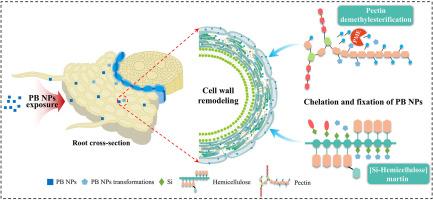普鲁士蓝纳米粒子对水稻的植物毒性及相关防御机制:体内观察和生理生化分析。
IF 8.1
2区 环境科学与生态学
Q1 ENVIRONMENTAL SCIENCES
引用次数: 0
摘要
虽然纳米毒性对植物的影响已得到广泛研究,但植物防御反应和抵抗纳米胁迫的基本机制仍未得到充分了解。特别是普鲁士蓝纳米粒子(PB NPs)已被广泛应用于颜料、制药、电催化、生物传感器和储能等领域。然而,普鲁士蓝纳米粒子对植物健康和生长的影响在很大程度上是未知的。本文探讨了 PB NPs 对水稻的植物毒性,并追踪了 PB NPs 的吸收、积累和生物转化,以及潜在的防御机制。结果表明,PB NPs(≥50 mg L-1)对水稻幼苗生长的抑制作用明显,在株高、芽生物量和根生物量方面的抑制率分别达到16.16%、27.80%和29.37%。X 射线光谱研究和体内元素及颗粒成像研究表明,PB NPs 是通过皮层经木质部从根部运输到芽的。然而,大部分 PB NPs 及其转化产物被保留在根部,由于根细胞壁(RCW)重塑,它们在根部受阻,81.4%-83.4% 的铁积累在 RCW 中,而对照组为 66.6%。具体来说,PB NPs 通过促进过氧化氢的产生来刺激果胶甲基酯酶的活性,从而参与 RCW 重塑。更有趣的是,在 RCW 重塑过程中,Si 被特异性地调节为与半纤维素共价结合,形成 Si- 半纤维素复合物,与 PB NPs 紧密结合,从而对 PB NPs 产生强大的防御作用。这些发现为人工 NPs 的植物毒性和植物的防御机制提供了新的见解。本文章由计算机程序翻译,如有差异,请以英文原文为准。

Phytotoxicity of Prussian blue nanoparticles to rice and the related defence mechanisms: In vivo observations and physiological and biochemical analysis
While the nanotoxic effects on plants have been extensively studied, the underlying mechanisms of plant defense responses and resistance to nanostress remain insufficiently understood. Particularly, Prussian blue nanoparticles (PB NPs) have been extensively used in pigments, pharmaceuticals, electrocatalysis, biosensors and energy storage. However, the impact of PB NPs on plants’ health and growth are largely unknown. Herein, the phytotoxicity of PB NPs to rice and trace the uptake, accumulation and biotransformation of PB NPs was explored, along with the underlying defence mechanisms. The results showed that PB NPs (≥50 mg L−1) significantly inhibited the growth of rice seedling up to 16.16%, 27.80%, and 29.37% in plant height, shoot biomass and root biomass, respectively. The X-ray spectroscopic studies and in vivo elemental and particle-imaging demonstrated that PB NPs were transported through the cortex via xylem from root to shoot. However, most of the PB NPs and their transformation products were retained in the root, where they were blocked owing to root cell wall (RCW) remodeling, and 81.4%–83.4% of Fe accumulated in the RCW compared to 66.6% in the control. Specifically, PB NPs stimulated pectin methylesterase activity by promoting hydrogen peroxide production to participate in RCW remodeling. More interestingly, Si was specifically regulated to covalently bind to hemicellulose to form the Si-hemicellulose complex that strongly bound with PB NPs during RCW remodeling, resulting in the strong defense against PB NPs. These findings provide new insights into the phytotoxicity of artificial NPs and the defense mechanisms of plants.
求助全文
通过发布文献求助,成功后即可免费获取论文全文。
去求助
来源期刊

Chemosphere
环境科学-环境科学
CiteScore
15.80
自引率
8.00%
发文量
4975
审稿时长
3.4 months
期刊介绍:
Chemosphere, being an international multidisciplinary journal, is dedicated to publishing original communications and review articles on chemicals in the environment. The scope covers a wide range of topics, including the identification, quantification, behavior, fate, toxicology, treatment, and remediation of chemicals in the bio-, hydro-, litho-, and atmosphere, ensuring the broad dissemination of research in this field.
 求助内容:
求助内容: 应助结果提醒方式:
应助结果提醒方式:


